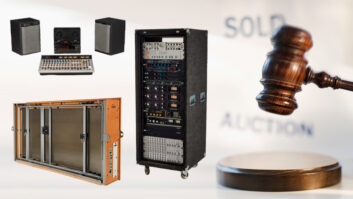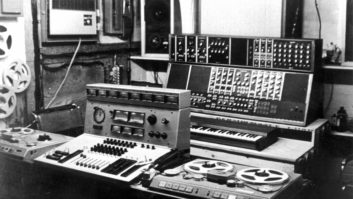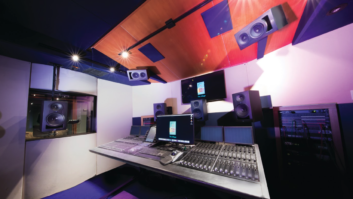It will probably always be known as “The Beatles’ studio.” Nearly every recording session in the group’s storied career took place in the large, 19th-century building on Abbey Road in the St. John’s Wood section of Northwest London — from “Love Me Do” to “The Long and Winding Road,” and everything in between: The sitar session for “Norwegian Wood,” the famous string crescendo for “A Day in the Life,” the worldwide broadcast of “All You Need Is Love”; literally, thousands of hours spent creating the most famous music catalog in music history. Beatles fans would hang around the outside of the studio hoping to catch a glimpse of their heroes coming or going, and a certain wall of the exterior became an ongoing message board for graffiti about and directed to the band. And then there’s the matter of The Beatles’ 1969 album cover for
Abbey Road: There were The Beatles walking across the street in front of what had long been known as EMI Studios, but which would forever after be known — first colloquially, then formally — as Abbey Road Studios.
Abbey Road is celebrating its 70th anniversary this year, a remarkable milestone in a tough, challenging business, where staying afloat 20 years is quite an accomplishment. And, truth be told, it has always been much more than “The Beatles’ studio.” It had already been going strong for 30 years before a Beatle ever set foot in the place, and in the more than three decades since they split up, there have been hundreds of important sessions in nearly every genre of music. It is not only the most famous studio in the world, but it is by nearly every measure one of the greatest.
And that has been the case from the beginning. The building at 6 Abbey Road was originally constructed as a large, private home in 1830. Nearly a century later, in 1927, a gentleman named Osmund “Ozzy” Williams came up with the notion of turning the building into studios for the burgeoning British recording industry. Unfortunately, Williams died before he could see his dream realized, but in November 1931, EMI (Electrical and Musical Industries Ltd.) opened the doors of its grand new studio with composer Sir Edward Elgar conducting the London Symphony Orchestra to record his inspirational ode to England, “Land of Hope and Glory.”
For the first decades of the studio’s existence, it was devoted mostly to the recording of classical music; indeed, it was designed with that in mind. (It also proved to be a popular studio for Big Band recording, attracting many of the top acts of the day. Glenn Miller’s final sessions were cut there, right before he disappeared on a pre-tour flight to Paris in 1944.) The legendary Studio One could accommodate an orchestra of more than 100 players and a full choir — its dimensions are 92×52 feet with a 40-foot ceiling — and it has remained essentially unchanged throughout the years (though the control room has been completely modernized and enlarged, and today boasts a Neve VRP Legend console). Studio Two, where The Beatles did the bulk of their recording, is roughly half the size of Studio One, but it is still large — it fits more than 50 players comfortably. These days, its control room is also outfitted with a Neve VRP Legend. Studio Three is smaller still, but can hold up to 15 players. Its control room is equipped with a 96-channel SSL 9000 J.
Recording tape was introduced in the late ’40s, LPs in the ’50s, and these developments combined to usher in the studio’s first Golden Era: Some of the finest classical recordings ever made were recorded at EMI during the ’50s, and they are still revered today. (Some of them were remastered at Abbey Road over the past few years for the ambitious Great Recordings of the Century series.) The year 1950 also marked the beginning of Beatle producer George Martin’s long tenure at the studio; he started out doing classical, but by the mid-’50s, Martin was also working on British comedy records by Peter Sellers’ group, Beyond the Fringe, and others.
By the end of the ’50s, the studio had started to venture into pop music recording — Cliff Richard scored a massive hit with “Move It” in 1958. But it was the arrival of the four lads from Liverpool in June 1962 that would transform both the studio and, of course, popular music in general. There was a veritable pop music explosion in Britain during the early and mid-’60s; besides The Beatles, EMI hosted recordings for such local luminaries as Cilla Black, The Hollies, Manfred Mann and Gerry & The Pacemakers.
According to Peter Mew, who came to Abbey Road as a tape op/tea boy in 1965, and who works as a post-production engineer there to this day, the pop and classical engineers “didn’t mix much professionally; you did one or the other, because it’s really a different kind of recording. Later on, you got some pop engineers who moved over into the classical field, but you never got it the other way. We all got along fine. There would be some heated discussions at lunch perhaps, but we were all keen to share what we knew with each other; it was always that way. I can remember long discussions over lunch about the Tamla/Motown sound and how that was achieved and the myths that went along with it. There was always a lot of interest in ‘the American sound.’”
In the early ’60s, there was still a prescribed career path for would-be engineers, and there was a strict delineation between the engineer’s job and a producer’s job. “There was a kind of career structure inasmuch as when you first started, you went into the tape library,” Mew says. “And the reason for that is, it gave you a chance to meet the people in the studios, find out what the rooms were, what went on there without getting involved in any of the technical issues. You usually stayed there for six months or so until somebody got promoted, and then you became an assistant, a tape op. Eventually, because people were always moving into dead men’s shoes, so to speak, everybody would move up, and the next step after tape op was cutting; don’t ask me why, but that’s the way it went. Then, from cutting you became an engineer. Now, this is the way it had always been. I’d been an assistant for a couple of years, I suppose, and then [engineer and later studio manager] Allen Stagg came in, and a couple of the engineers left and one of them suggested, ‘Why not try Pete Mew?’ So I was the first person who never did the cutting step; I went from tape op to engineer.” Mew’s first session as engineer was for the Pretty Things’ S.F. Sorrow album in late 1967.
EMI Studios always had the latest and best equipment. Even in the mono days (the first Beatles album in stereo was Help! in 1965), its EMI custom consoles were considered state-of-the-art, and it had an unparalleled collection of mostly German microphones — “all of our microphones were either Neumann or AKG, with a few BBC ribbon mics,” Mew says.
“When I first arrived here 30 years ago,” says current director of operations Chris Buchanan, “EMI was still building a lot of their own equipment, including special cutting desks, which were superb. It was nice, because in those days, it was purely for internal use. They had to be the best; the cost didn’t seem to matter terribly much. All the switches were special hard gold, and it was all hand-built and hand-adjusted and incredibly expensive. Those desks are still out there, too. Oasis has bought one of them. Another recently sold for over 100,000 pounds.”
The success of The Beatles had a lasting impact on Abbey Road beyond its reputation — the group ushered in changes in the way the studio operated. During their early days, The Beatles worked like any other group, churning out records quickly and efficiently; they were just one of a number of groups booking short blocks of time in the studio. But as their albums became more complex — from Rubber Soul on — they needed more studio time and worked longer hours, forcing their engineers to conform to their needs, whereas previously, the studio had been in complete control over when and how long the band recorded. And because of their close partnership with George Martin and their various engineers, The Beatles also became more intimately involved in the actual recording process than pop artists had previously.
“Before the late ’60s,” remarks Peter Mew, “there was a rather strict delineation of roles. Producers produced, engineers engineered and the artists did whatever they were told. The big record companies were all-powerful and they dictated to the artists what they would do. But, of course, come the end of the ’60s, the artists got bigger than the record companies in a lot of cases, and they were able to turn around and dictate to the record companies. And as more record companies came along, especially smaller ones, things changed and the artists got more and more power. Then they started building their own studios and becoming their own producers, and that changed things, as well.”
By the early ’70s, The Beatles disintegrated into four solo careers, and Pink Floyd was the top rock band at Abbey Road — all of their classic albums from that era were cut there, including Dark Side of the MoonWish You Were Here. The group became famous for its long, laborious sessions; indeed, one story has studio manager Allen Stagg turning off the power in Studio Three one night because he was so fed up with Pink Floyd working into the wee hours. Of course, that would become the norm in the studio business the world over by the mid-’70s, and it’s stayed that way ever since.
and
“Lockouts started happening here in the mid- to late ’70s,” Mew says. “Most albums in the early ’70s took four to six weeks, which is still a lot longer than most records in the ’60s. But with the coming of 24-track and groups who could command the budgets to do lockouts, everything started to take longer and longer; I don’t know if that’s a good or a bad thing…”
On the technical side, the studio embraced each new development, as 4-track gave way to 8-track, then 16-track, and so on, up through Sony digital multitracks and Pro Tools. “When the first 8-tracks came in, we continued to use the EMI valve consoles,” Mew says, “because you were only recording a few tracks at a time. But pretty rapidly, EMI developed an 8-track console that was transistorized, and that then became our standard console. That was then expanded to 16 tracks when that came in. I think the first non-EMI console we bought was a Neve for Studio Three; that would have been in 1974 or ’75.”
Mew notes that the trend of deadening studios during the ’70s never caught on at Abbey Road: “It really wasn’t feasible. We looked into buying screens and that kind of thing, but because we were always so multidimensional, and the studios were still used for orchestral sessions, you couldn’t deaden them down so that they could only be used for pop records.”
With the recording of classical music either static or in decline over the past two decades, EMI/Abbey Road has, like all big studios, been forced to look for new sources of revenue for its biggest rooms. The studio continues to draw big pop/rock acts — everyone from Paul McCartney, Radiohead and the Spice Girls, to Oasis, Manic Street Preachers and Spiritualized. But also, since the late ’70s, the studio has become a first-call facility for cutting film music — the combination of the magnificent Studio One acoustics and the availability of top local orchestras, such as the London Symphony, made it a magnet both for Hollywood producers and European filmmakers. Recording film music is now a core business for Abbey Road, and, not surprisingly, the studio also does a significant amount of surround mixing.
Senior recording engineer Peter Cobbin, who joined the Abbey Road staff after many years as a successful engineer in his native Australia, notes, “There still is really no better place to do orchestral work than Studio One. It’s a brilliant room.”
Though a veteran, Cobbin is one of the new breed of Abbey Road engineers who are versatile enough to work in many styles and in different recording media. When we spoke, he had just completed sessions with composer Lalo Schifrin that used 48 tracks of Pro Tools with 48 Prism AD/DA converters, using a Sony 3348 as a backup, all mixed on the SSL 9000 J. Two years ago, he was responsible for the surround mixes for the remastered version of The Beatles’ Yellow Submarine. (“I believe that was the first time any engineer had been asked to remix Beatles tracks from the original multitracks,” he says with evident pride.) He mixed Howard Shore’s Oscar-nominated soundtrack for the first Lord of the Rings film. And he’s done work on rock DVDs for the likes of U2 and Björk. “I must say, having the 96-channel SSL J Series has made jumping into 5.1 a dream. We now have 12 rooms here that have 5.1 setups in them; it’s a major commitment.”
The studio has also done recordings for SACD and DVD-A releases, DVD authoring, and through its successful Abbey Road Interactive wing, has attracted a steady stream of multimedia clients. Another long-term project for the studio is to digitally archive all 250,000 tapes in their library to preserve them for future generations.
“If you don’t change, you don’t survive,” says Buchanan matter-of-factly. “We’re very much client-driven these days. When I first started here in 1972, it was pretty much the chief engineer who told you what technology was allowed to be used in the studio. Nowadays, it’s gone completely commercial, and whatever a client asks for, we tend to provide. So, if we get a lot of inquiries in one area, we’ll equip accordingly; or perhaps hire initially.”
Though still affiliated with EMI, much of their work comes from outside vendors today, and their large staff of house engineers shares the space with independents that come in on a project-by-project basis.
It’s an interesting balancing act the studio is constantly engaged in: On the one hand, everyone who works at Abbey Road is justifiably proud of the history that fairly oozes from every room. On the other, they want to be seen as a modern, forward-looking studio always ahead of the technological curve.
“Everybody who comes here to work always says, ‘Wow, this is fantastic; you can really feel the atmosphere, feel the history,’” says Peter Mew. “There are always going to be people who say, ‘Oh, Abbey Road — Beatles; living in the past.’ But it isn’t that way, and anyone who comes to work here knows it isn’t that way. We’ve got modern equipment and engineers who can handle it. But you still know you’re someplace special.
“I work in a room at the front of the building, and I look out on Abbey Road, and I see the tourists coming along and signing the wall day after day after day. There aren’t many studios in the world where that happens. It’s not Buckingham Palace, you know. But I’m looking out now and there are flowers all the way along the railings because of George [Harrison, who had died two days earlier]. It’s a special place, for innumerable reasons.”
Peter Cobbin concurs. “I appreciate the sense of history about this place, and I’m keen to pass that along to some of the younger chaps coming through the business — that we are part of something bigger than all of us. And while we don’t want to just rest on our laurels, we can learn a lot from the legacy that’s been bestowed to us.”
Blair Jackson is Mix‘s senior editor.







